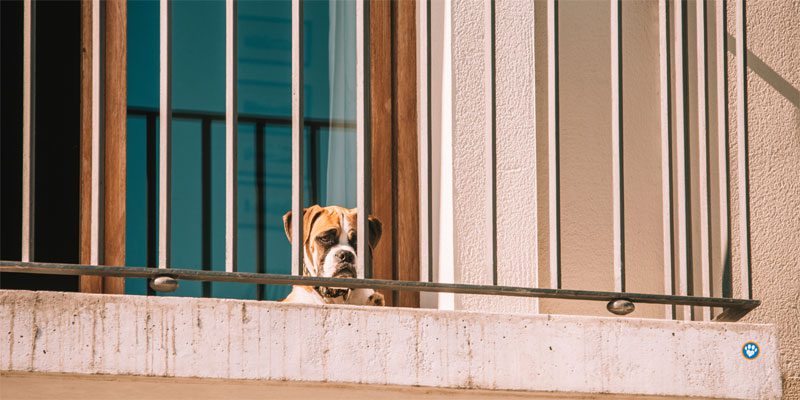Keeping A Dog In A Flat – The Practicalities.
If you live in a flat, or apartment and have a dog – (or are thinking of getting a dog ) – there are a lot of considerations to take into account. Read our Holidays4Dogs guide on keeping a dog in a flat – including tips on practicalities and legalities.
Having a dog in your life is a very special thing, but they do have particular needs. Keeping a dog in a flat isn’t impossible and many dogs can live in apartments perfectly happily. However, it may be a little more challenging for owners when their pet doesn’t have immediate access to the outdoors. If you take the right steps, it can be possible to live in a flat with a dog.
To help you decide, here are a few questions to consider; –
If you rent your home – does the landlord allow pets?
If you own your flat – does the lease allow pets?
What is access is there to the outdoors – stairs/lift/ground floor?
Do you have plenty of time?
Is there enough space?
Check the lease, or contract, of your home.
Even if you own your flat, check the terms of your contract. Freehold properties don’t usually have restrictions on keeping pets, although some older freehold’s do. Leasehold properties are different and you may find pets are barred. However, this isn’t always the case – so check the small print carefully. If your lease states that pets are not allowed, you still might be able to get permission from the freeholder.
Keeping it neighbourly.
Once you have confirmed pets are allowed in your flat, it may also be worth speaking to other residents and especially your immediate neighbours. Making sure your neighbours know you are committed to having a dog, while making sure your dog is not a nuisance to others, is a good way to keep the neighbours sweet.
Make sure you clear up after your dog in the communal areas and take time to train your dog, paying particular attention to reducing issues arising from separation anxiety. One of the biggest bug bears about dogs living in flats, is the potential noise that neighbours may hear. Barking is natural, but most neighbours won’t tolerate incessant barking, or howling.
How much time do you have to spend with your dog?
Wherever you live with your dog, whether it’s a house in the country, or a flat in the city, – dogs require a lot more attention than other pets, such as cats. Living in a flat means you will need to spend more time taking your dog outside. If you have a busy schedule, this may make things a little more challenging. Puppies, in particular, need a lot of time given over to house-training – this may mean taking your puppy outside every hour, or so, in the early days. If access to outside space takes a long time – several flights of stairs for instance – house training may take longer and you may need to prepare for more accidents in the house.
‘Bathroom’ facilities.
Mature dogs that have a good routine for toileting in place won’t pose so much of a problem if you live in a flat. Puppies, however, are a bit different as they need to go outside regularly – often at short notice.
If you live in a ground floor flat, with access to a garden this won’t pose a problem. However, if you live a few floors up, housetraining is going to be tricky. By the time you’ve got outside, your dog may have already had an accident, either in the house, or in the communal inside area – ( which may not make you popular with neighbours!).
Consider what outdoor space is very nearby. Is there a communal garden, or is there only street or pavement space?
For small breed dogs, you could provide a litter tray or, use puppy pads. If you’re going to use a tray, avoid using cat litter as the substrate (puppies may eat this). This should work in the short term and prevent accidents on the carpet, but it is still important to teach your dog to toilet outside. Otherwise, your dog may refuse to perform while on a walk and wait to get back home to use the litter tray instead.
Bear in mind – taking your dog out early in the morning for the first bathroom stop of the day, or late at night for last ablutions – won’t be as easy as just opening a door and letting your dog into the garden while still in your pj’s.
Space and safety.
Is your flat big enough to accommodate your dog’s needs? Some breeds of dog are on the go all the time – even after a good amount of exercise outdoors. Working breeds may be less inclined to live in more confined spaces whereas, others, will be happy to curl up on the couch and relax, once indoors. It’s important to do lots of research on the kinds of dogs more likely to suit your lifestyle.
If you live above ground level, you will need to consider safety aspects of windows and balconies. Having windows open too far can pose a risk of your dog falling, or jumping out. If you don’t have safety catches which prevent windows from being opened too far, you may need have some fitted. Alternatively, you may need to cover windows with a suitable safety barrier.
Mental stimulation.
Every dog needs daily exercise. Living in a flat, this may mean several trips outdoors – not just one, or two, walks a day. Every dog also requires a great deal of mental stimulation and this might be more important if you live in a flat.
Keeping your dog mentally stimulated will prevent boredom and, therefore, reduce any undesirable behaviours, such as barking. Provide your dog with lots of puzzle toys, such as Kongs. You can still play games with your dog in a flat too! Hiding things for your dog to find is ideal.
Is it unfair to keep a dog in a flat?
Gardens are really only for the convenience of owners and many dogs can live happily in apartments as long as owners can commit to regular exercise, mental stimulation and socialising to compensate. However, it is crucial to consider a dog’s individual needs because, not all dogs will be suitable for apartment living.
Key Points.
Are you allowed dogs? – check the terms of lease, or contract, to make sure dogs are allowed to live in the flat.
Choose the right breed – small quieter breeds may be better suited to apartment living. Alternatively, older rescue dogs may settle better to living in a flat.
Access to outdoor space – does the flat have access to a communal garden? This will be more beneficial and easier. If there is only pavement, or car park space and you have to walk to get to grass, or open communal area, this will make it harder when it comes to taking your dog out for short bathroom stops.
Regular exercise – do you have the time to exercise your dog? Living in a flat will mean many more trips outside.
Mental stimulation – your dog will benefit from lots of enrichment activities to prevent undesirable behaviour.
Respecting neighbours – always be mindful of your immediate neighbours. Ensure your dog is well trained, sociable and clean.





